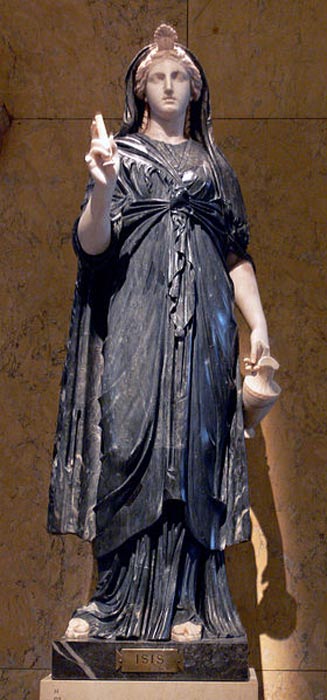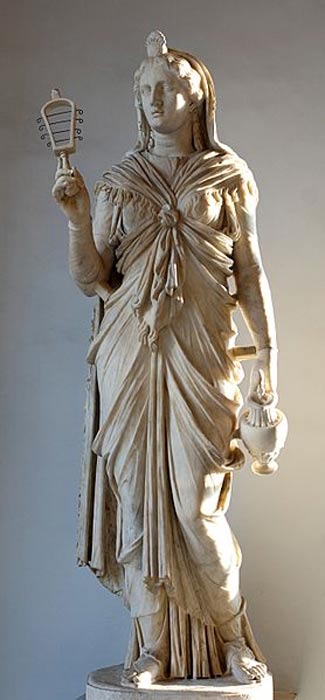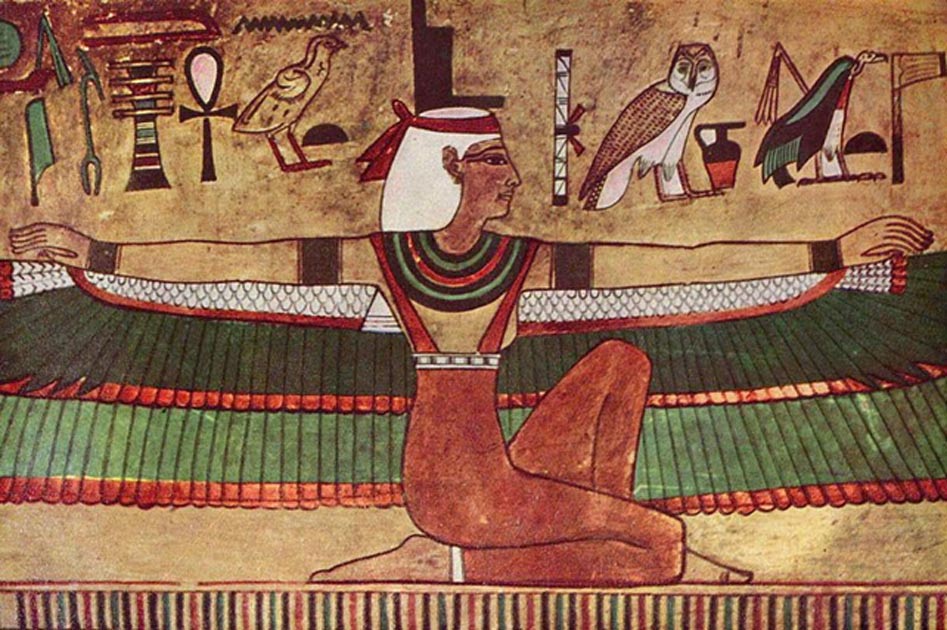Isis, An Egyptian Goddess Who Spread Her Wings Across Europe
When the Romans entered Egypt they saw a land of magnificent temples, impressive and monumental statues, and symbolism they did not understand. The Greeks felt the same when they explored the country near the Nile. The beauty and mysterious smile of Isis stole the hearts of many non-Egyptian visitors, who decided to bring her idolization abroad and make her an important figure in many parts of Europe and Asia.
Isis was one of the most important deities of Ancient Egypt. She was Osiris’ wife and an archetype of the good wife and mother. The goddess was a patron of nature and magic and a helper who supported women and their families. Isis was one of the most embraced deities, and her cult was so open that almost every person could find a reason to follow her.

Isis in black and white marble (Roman, 2nd century AD). (Public Domain)
The Goddess Expands Her Wings
Temples to Isis have been discovered in many parts of the Roman Empire, including Rome, Pompeii, Spain, and the Greek Islands. Most of them come from the 1st or 2nd century AD, suggesting that the goddess became popular outside Egypt after the collapse of the last Egyptian pharaoh – Cleopatra VII. The descriptions of the palace where the pharaoh lived contains some suggestions showing her as a queen-goddess associated with Isis. However, it is unclear if Cleopatra was responsible for bringing Isis to Rome.
The Roman Empire later became a conduit for the European fame of the goddess Isis.
- The Egyptian Goddess Isis, Found in India
- Was Comic Book Hero Superman Influenced by the Ancient Egyptian Sun God Horus?
- The sacred and magical sistrum of ancient Egypt

Roman statue of Isis holding a sistrum and an oinochoe. Capitoline Museum. (Public Domain)
Isis also became popular in Greco-Roman temples. Apart from the temples in Alexandria, including the Roman ones dedicated to the trinity of Isis: Isis, Serapis, and Herpocrates, there were temples dedicated to the goddess in other parts of the Mediterranean Sea, like on Delos, a Greek island. According to ancient mythology, Delos island is the birthplace of the Greek goddess Artemis and the god Apollo as well. The temple of Isis was built as the third of the most popular temples on the island.
The temple of Isis in Pompeii is famous for being well-preserved, and there are recordings in other places of a cult to the goddess in London too. One of the most surprising places of the Isis cult was an ancient Roman city called Iria Flavia, the current city of Padron, very close to Santiago de Compostela in Spanish Galicia. Researchers usually believe that it was an area dominated by the deities of Rome and pre-Roman cultures including the Celts.

Mural showing Io being welcomed into Egypt by Isis. Roman fresco from the temple of Isis in Pompeii. (Public Domain)
According to Francesco Tiraditti:
“Except for some slight changes added by popular tradition, the story of the death and resurrection of Osiris remained unchanged until the Roman Period and beyond it. The myth was rewritten by Plutarch (45 – 125 AD) n a book entitled ''De Iside et Osiride''. According to Plutarch, he had written this work when he was a priest in Delphes (around 100 AD). The introduction was dedicated to Clea, an Isiac priestess who was a friend of the author. The role of Isis, which had been consolidated by a long tradition, remained unchanged in Plutarch's narration. However, the episode in which the coffin containing Osiris's remains was thrown into the sea by Seth and reached Byblos is known only by Plutarch. The Plutarch's version of the myth of Osiris in the literary source had the greatest influence in the western world, especially during the Renessaince. For example Pinturicchio's decoration of the Sala dei Santi of the Borgia apartment in the Vatican Palace, was totally influenced by Plutarch's legend.”
- The Goddess Tyche as Lady Luck
- Cleopatra probably did not die of snakebite to her breast, Egyptologist claims
- Archeologists discover Mythical Tomb of Osiris, God of the Dead, in Egypt

Temple of Isis in Delos, Greece. (Bernard Gagnon/CC BY SA 3.0)
It That Isis or Mary with Her Divine Child?
Researchers also unearthed a few artifacts related to the ancient Egyptian civilization in the territory of what is now Poland. The most unexpected items were the statuettes of the goddess Isis. According to different resources, researchers found two or even three examples like this during the 19th century. Unfortunately, these artifacts were lost during World War II. However, the descriptions and some photographs allow one to suppose that there was a fascinating story behind these artifacts. It seems that they were not just souvenirs which had arrived to central Europe from a faraway land.
One of the bronze statues discovered in Western Poland had the horns and solar disc of Isis cut off in a very precise way. Why did someone cut off these characteristics? It's easy to explain. During the period of early Christianity in central Europe, people noticed a similarity between Isis with Horus- Hapocrates and Mary with Jesus.

An 1888 drawing of a statue of Isis and Horus. (Public Domain) The Nursing Madonna by unknown master from Bruges, 16th century. Museu de Aveiro, Portugal. (Public Domain)
It was also a period when a statuette was very costly to make, so those who sold such items started to recycle the ancient figurines. They began to cut off the horns with the solar disc of Isis, so they could receive a ready to sell product – a wonderful statuette of Mary with her child Jesus.
The “new” statue was perhaps described as an object which will bring good luck, peace, and blessings to one’s home. This process could have been common in other parts of Europe as well. However, some of the researchers before World War II wondered if it was possible that the cult of Isis arrived to the current territory of Poland on its own.
The Tale of the Goddess Holds Strong
The goddess Isis is one of the most mysterious and revered deities of ancient Egypt. There are some records which prove her cult also existed in Asia, for example traces of the goddess have been discovered in India. Moreover, her name remained in Europe – hidden in the name Isidor (Greek Isidoros and Isidora), meaning the ''gift of Isis''. It was the name of a few Christian saints, and a very popular name especially during the middle ages. It is actually still in use. Isis became an icon of pop culture and remains one of the symbols of Egypt even today.

Temple of Isis in Philae, Egypt. (c. 1923) Brooklyn Museum Archives. (Brooklyn Museum)
Top Image: Mural depicting Isis in thetomb of Seti I in the Valley of the Kings (KV17). Source:Public Domain
References:
Plutarch: Isis and Osiris, available at:
http://penelope.uchicago.edu/Thayer/E/Roman/Texts/Plutarch/Moralia/Isis_and_Osiris*/home.html
Isis, the Egyptian Goddess who Conquered Rome: Egyptian Museum of Cairo, November 29-December 31, 1998 by Francesco Tiradritti, available at:
https://www.academia.edu/719626/Isis_the_Egyptian_Goddess_who_Conquered_Rome_Egyptian_Museum_of_Cairo_November_29-December_31_1998
The Worship of Isis and Serapis in Nomentum (Rome). Some Epigraphic and Archaeological Evidence by Alessandra Colazilli, available at:
https://www.academia.edu/5037513/The_Worship_of_Isis_and_Serapis_in_Nomentum_Rome_._Some_Epigraphic_and_Archaeological_Evidence
Znaleziska zabytków egipskich na terenie Polski by Joachim Śliwa, available at:
http://www.archeo.uw.edu.pl/swarch/Swiatowit-r2000-t2_(43)-nA-s187-192.pdf

















Comments
In my reading, I have run across references to Mary Magdalene as a priestess of Isis, and that Isis worship was also in southern France (Septimania) where she emigrated after the crucifixion of Jesus. Has anyone else encountered any such references?